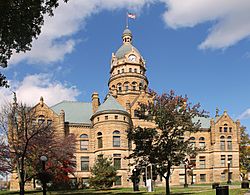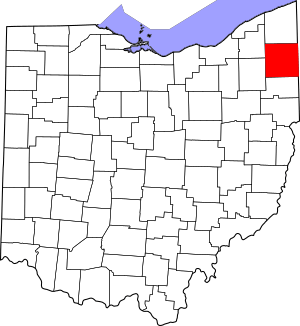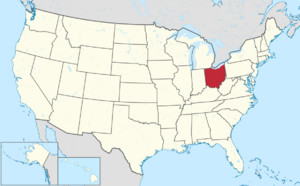Trumbull County, Ohio facts for kids
Quick facts for kids
Trumbull County
|
|||
|---|---|---|---|

Trumbull County Courthouse
|
|||
|
|||

Location within the U.S. state of Ohio
|
|||
 Ohio's location within the U.S. |
|||
| Country | |||
| State | |||
| Founded | July 10, 1800 | ||
| Named for | Jonathan Trumbull | ||
| Seat | Warren | ||
| Largest city | Warren | ||
| Area | |||
| • Total | 637 sq mi (1,650 km2) | ||
| • Land | 618 sq mi (1,600 km2) | ||
| • Water | 18 sq mi (50 km2) 2.9%% | ||
| Population
(2020)
|
|||
| • Total | 201,977 | ||
| • Estimate
(2021)
|
201,335 |
||
| • Density | 317.08/sq mi (122.42/km2) | ||
| Time zone | UTC−5 (Eastern) | ||
| • Summer (DST) | UTC−4 (EDT) | ||
| Congressional district | 14th | ||
Trumbull County is a county in the far northeast portion of the U.S. state of Ohio. As of the 2020 census, the population was 201,977. Its county seat and largest city is Warren, which developed industry along the Mahoning River. Trumbull County is part of the Youngstown–Warren, OH Metropolitan Statistical Area.
Contents
History
In the early years of the European discovery and exploration of the New World, the land that became Trumbull County was originally claimed by French explorers as part of the French colony of Canada (New France). Their settlements had some fur traders who interacted with Native American tribes in this area. After losing the Seven Years' War to Great Britain, France was forced to cede its territories east of the Mississippi River in 1763. Great Britain renamed New France as the Province of Quebec.
Following the United States' victory in its Revolutionary War, the British were forced to cede this land to the new nation. The federal government convinced Connecticut to give up its claim to the land, but it was known as part of the Connecticut Western Reserve in the Northwest Territory. Connecticut retained sovereignty over some of the eastern portion of what became Ohio, selling this area in 1795 to the Connecticut Land Company, a speculative private development firm. As first organized, Trumbull County consisted of the entire area of the Connecticut Western Reserve before population increased, and it was divided into smaller counties. The county's main city, Warren, was originally founded as the capitol of the Western Reserve territory.
No Native American settlements have ever formally been identified in Trumbull County, however artifacts are uncovered often. Early settlers did believe they noted an ancient village site in Kinsman, a more contemporary site in Hartford and several strange stone constructions were noted in the Black Ash Swamp by early Bristol residents- this area now known as the Grand River Preserve. Many presumably different groups of Natives were still frequenting camps in the vicinity of Newton Falls and somewhere near the Champion-Warren township border when modern Americans first began to settle there. Several of the names of specific Native persons are echoed across most of these early residents' histories- namely Cadashaway, Paqua and Kiogg. A memorial stone piles believed to have been Native in origin was situated on the West Bank of the Mahoning, but was later removed for construction purposes. Before 1600, the area was ambiguously between the territories of the Erie people to the east and the Whittlesey Culture to the west. It is currently unknown precisely where one tribe's territory ended and the other began. After the Beaver Wars, the area was frequented by travelling Lenape, Wyandot, Ottawa, Shawnee and Seneca, who all had settlements nearby for a time and shared the valley's animal, food and medicinal resources. They also regularly panned for salt in the marshes. The Natives collectively used this area as a shared hunting ground, but had to give up ownership of the region for settlement as punishment for participating in the Northwest Indian War. However, early residents say Natives still frequented the area until roughly 1811. Some of the final Native residents were camped along the Grand River in Mespotamia during the war, leading to an upsetting altercation in which the locals found and ransacked their camp and, as a warning to leave, carved an image of a Native man into a tree and shot it. The Natives responded by carving a white man into a tree without a mark on it, but seem to have later felt it was unsafe to stay and left. They could have gone south to Prophetstown, a religious compound run by Tecumseh's brother, and got caught up in the Shawnee War and War of 1812, or they and several other Native communities scattered around northeast Ohio may have condensed into a handful of settlements in the Cuyahoga River, before the majority of them relocated west in 1813 to either live with the main Ottawa or Wyandot tribe. Only a handful of Native individuals were left throughout all of Northeast Ohio and historically recorded following this.
The county is named for Jonathan Trumbull, Governor of Connecticut, who once owned the land in this region. Early settlements were made along the Mahoning River and other waterways, which provided transportation access and water power to the industries that developed later in the 19th century.
Geography
According to the United States Census Bureau, the county has a total area of 637 square miles (1,650 km2), of which 618 square miles (1,600 km2) is land and 18 square miles (47 km2) (2.9%) is water. It is approximately a square with sides of 25 miles; it is the only square county in Ohio.
Adjacent counties
- Ashtabula County (north)
- Crawford County, Pennsylvania (northeast)
- Mercer County, Pennsylvania (east)
- Mahoning County (south)
- Portage County (southwest)
- Geauga County (northwest)
Major highways
 US 62
US 62 US 422
US 422 I-80
I-80 SR 5
SR 5 SR 7
SR 7 SR 11
SR 11 SR 45
SR 45 SR 46
SR 46 SR 82
SR 82 SR 87
SR 87 SR 88
SR 88 SR 169
SR 169 SR 193
SR 193 SR 303
SR 303 SR 304
SR 304 SR 305
SR 305 SR 534
SR 534 SR 609
SR 609 SR 616
SR 616 SR 711
SR 711
Demographics
| Historical population | |||
|---|---|---|---|
| Census | Pop. | %± | |
| 1800 | 1,302 | — | |
| 1810 | 8,671 | 566.0% | |
| 1820 | 15,546 | 79.3% | |
| 1830 | 26,153 | 68.2% | |
| 1840 | 38,107 | 45.7% | |
| 1850 | 30,490 | −20.0% | |
| 1860 | 30,656 | 0.5% | |
| 1870 | 38,659 | 26.1% | |
| 1880 | 44,880 | 16.1% | |
| 1890 | 42,373 | −5.6% | |
| 1900 | 46,591 | 10.0% | |
| 1910 | 52,766 | 13.3% | |
| 1920 | 83,920 | 59.0% | |
| 1930 | 123,063 | 46.6% | |
| 1940 | 132,315 | 7.5% | |
| 1950 | 158,915 | 20.1% | |
| 1960 | 208,526 | 31.2% | |
| 1970 | 232,579 | 11.5% | |
| 1980 | 241,863 | 4.0% | |
| 1990 | 227,813 | −5.8% | |
| 2000 | 225,116 | −1.2% | |
| 2010 | 210,312 | −6.6% | |
| 2020 | 201,977 | −4.0% | |
| 2021 (est.) | 201,335 | −4.3% | |
| U.S. Decennial Census 1790-1960 1900-1990 1990-2000 2010-2020 |
|||
2010 census
As of the census of 2010, there were 210,312 people, 86,011 households, and 56,874 families living in the county. The population density was 340.1 inhabitants per square mile (131.3/km2). There were 96,163 housing units at an average density of 155.5 units per square mile (60.0 units/km2). The racial makeup of the county was 89.0% white, 8.3% black or African American, 0.5% Asian, 0.2% American Indian, 0.3% from other races, and 1.8% from two or more races. Those of Hispanic or Latino origin made up 1.3% of the population. In terms of ancestry, 21.6% were German, 16.5% were American, 14.3% were Irish, 13.7% were Italian, and 10.6% were English.
Of the 86,011 households, 28.8% had children under the age of 18 living with them, 47.4% were married couples living together, 13.7% had a female householder with no husband present, 33.9% were non-families, and 29.2% of all households were made up of individuals. The average household size was 2.40 and the average family size was 2.95. The median age was 42.8 years.
The median income for a household in the county was $42,296 and the median income for a family was $52,731. Males had a median income of $43,382 versus $30,859 for females. The per capita income for the county was $21,854. About 11.5% of families and 15.4% of the population were below the poverty line, including 24.9% of those under age 18 and 8.1% of those age 65 or over.
Higher learning
- Kent State University Trumbull is a regional campus of Kent State University, offering several associate degrees and a few bachelor's degrees.
- Trumbull County Career and Technical Center is a vocational school, offering different learning and career advancement opportunities for both high school and adult learners.
Communities
Cities
Villages
- Lordstown
- McDonald
- Newton Falls
- Orangeville
- West Farmington
- Yankee Lake
Townships
- Bazetta
- Bloomfield
- Braceville
- Bristol
- Brookfield
- Champion
- Farmington
- Fowler
- Greene
- Gustavus
- Hartford
- Howland
- Hubbard
- Johnston
- Kinsman
- Liberty
- Mecca
- Mesopotamia
- Newton
- Southington
- Vernon
- Vienna
- Warren
- Weathersfield
Defunct township
Census-designated places
Unincorporated communities
Ghost towns
- Antietam (in Hartford)
- Bentley (in Brookfield)
- Brockway (in Hartford)
- Chestnut Ridge (in Hubbard)
- Dewey (in Kinsman)
- Doughton (in Hubbard)
- Germantown (in Hubbard)
- Kingsbury (in Mecca)
- Longsville (in Hubbard)
- Mosier (in Liberty)
- Oil Diggings (in Mecca)
- Old Burg Hill (in Hartford)
- Penza (Liberty/ Hubbard border)
- Superior (in Vernon)
- Walnut Hill (in Brookfield)
- Wassie (Bristolville/ Champion border)
- York (in Gustavus)
- Ohltown (in Weathersfield)
The Camp Ravenna Joint Military Training Center, formally known as the Ravenna Training and Logistics Site and commonly known as the Ravenna Arsenal, occupies a small part of Braceville Township.
See also
 In Spanish: Condado de Trumbull para niños
In Spanish: Condado de Trumbull para niños




